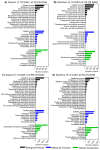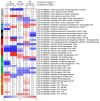Comparative Root Transcriptomics Provide Insights into Drought Adaptation Strategies in Chickpea (Cicer arietinum L.)
- PMID: 32150870
- PMCID: PMC7084756
- DOI: 10.3390/ijms21051781
Comparative Root Transcriptomics Provide Insights into Drought Adaptation Strategies in Chickpea (Cicer arietinum L.)
Abstract
Drought adversely affects crop production across the globe. The root system immensely contributes to water management and the adaptability of plants to drought stress. In this study, drought-induced phenotypic and transcriptomic responses of two contrasting chickpea (Cicer arietinum L.) genotypes were compared at the vegetative, reproductive transition, and reproductive stages. At the vegetative stage, drought-tolerant genotype maintained higher root biomass, length, and surface area under drought stress as compared to sensitive genotype. However, at the reproductive stage, root length and surface area of tolerant genotype was lower but displayed higher root diameter than sensitive genotype. The shoot biomass of tolerant genotype was overall higher than the sensitive genotype under drought stress. RNA-seq analysis identified genotype- and developmental-stage specific differentially expressed genes (DEGs) in response to drought stress. At the vegetative stage, a total of 2161 and 1873 DEGs, and at reproductive stage 4109 and 3772 DEGs, were identified in the tolerant and sensitive genotypes, respectively. Gene ontology (GO) analysis revealed enrichment of biological categories related to cellular process, metabolic process, response to stimulus, response to abiotic stress, and response to hormones. Interestingly, the expression of stress-responsive transcription factors, kinases, ROS signaling and scavenging, transporters, root nodulation, and oxylipin biosynthesis genes were robustly upregulated in the tolerant genotype, possibly contributing to drought adaptation. Furthermore, activation/repression of hormone signaling and biosynthesis genes was observed. Overall, this study sheds new insights on drought tolerance mechanisms operating in roots with broader implications for chickpea improvement.
Keywords: abiotic stress; chickpea; drought; gene expression; hormone; root; signaling.
Conflict of interest statement
The authors declare no conflict of interest.
Figures







Similar articles
-
Comparative analysis of expressed sequence tags (ESTs) between drought-tolerant and -susceptible genotypes of chickpea under terminal drought stress.BMC Plant Biol. 2011 Apr 22;11:70. doi: 10.1186/1471-2229-11-70. BMC Plant Biol. 2011. PMID: 21513527 Free PMC article.
-
Transcriptome analyses reveal genotype- and developmental stage-specific molecular responses to drought and salinity stresses in chickpea.Sci Rep. 2016 Jan 13;6:19228. doi: 10.1038/srep19228. Sci Rep. 2016. PMID: 26759178 Free PMC article.
-
RNA-Seq analysis revealed genes associated with drought stress response in kabuli chickpea (Cicer arietinum L.).PLoS One. 2018 Jun 28;13(6):e0199774. doi: 10.1371/journal.pone.0199774. eCollection 2018. PLoS One. 2018. PMID: 29953498 Free PMC article.
-
A Comprehensive Review on Chickpea (Cicer arietinum L.) Breeding for Abiotic Stress Tolerance and Climate Change Resilience.Int J Mol Sci. 2022 Jun 18;23(12):6794. doi: 10.3390/ijms23126794. Int J Mol Sci. 2022. PMID: 35743237 Free PMC article. Review.
-
Advancing Chickpea Breeding: Omics Insights for Targeted Abiotic Stress Mitigation and Genetic Enhancement.Biochem Genet. 2025 Apr;63(2):1063-1115. doi: 10.1007/s10528-024-10954-8. Epub 2024 Nov 12. Biochem Genet. 2025. PMID: 39532827 Review.
Cited by
-
The Effects of Seed Pretreatment with Endophytic Bacteria Bacillus subtilis on the Water Balance of Spring and Winter Wheat Seedlings under Short-Time Water Deficit.Plants (Basel). 2023 Jul 18;12(14):2684. doi: 10.3390/plants12142684. Plants (Basel). 2023. PMID: 37514298 Free PMC article.
-
Emerging Roles of SWEET Sugar Transporters in Plant Development and Abiotic Stress Responses.Cells. 2022 Apr 12;11(8):1303. doi: 10.3390/cells11081303. Cells. 2022. PMID: 35455982 Free PMC article. Review.
-
Exogenous Sodium Nitroprusside Affects the Redox System of Wheat Roots Differentially Regulating the Activity of Antioxidant Enzymes under Short-Time Osmotic Stress.Plants (Basel). 2024 Jul 9;13(14):1895. doi: 10.3390/plants13141895. Plants (Basel). 2024. PMID: 39065422 Free PMC article.
-
A glutathione-independent DJ-1/Pfp1 domain containing glyoxalase III, OsDJ-1C, functions in abiotic stress adaptation in rice.Planta. 2024 Mar 4;259(4):81. doi: 10.1007/s00425-023-04315-9. Planta. 2024. PMID: 38438662
-
Comparative transcriptome analysis reveals key long noncoding RNAs for cadmium tolerance in Tibetan hull-less barley.Front Plant Sci. 2025 May 22;16:1572490. doi: 10.3389/fpls.2025.1572490. eCollection 2025. Front Plant Sci. 2025. PMID: 40475905 Free PMC article.
References
-
- Farooq M., Wahid A., Kobayashi N., Fujita D., Basra S. Sustainable Agriculture. Springer; Berlin/Heidelberg, Germany: 2009. Plant drought stress: Effects, mechanisms and management; pp. 153–188.
-
- Leport L., Turner N.C., Davies S.L., Siddique K.H.M. Variation in pod production and abortion among chickpea cultivars under terminal drought. Eur. J. Agron. 2006;24:236–246. doi: 10.1016/j.eja.2005.08.005. - DOI
-
- Fang X., Turner N.C., Yan G., Li F., Siddique K.H.M. Flower numbers, pod production, pollen viability, and pistil function are reduced and flower and pod abortion increased in chickpea (Cicer arietinum L.) under terminal drought. J. Exp. Bot. 2009;61:335–345. doi: 10.1093/jxb/erp307. - DOI - PMC - PubMed
MeSH terms
Substances
Grants and funding
LinkOut - more resources
Full Text Sources

